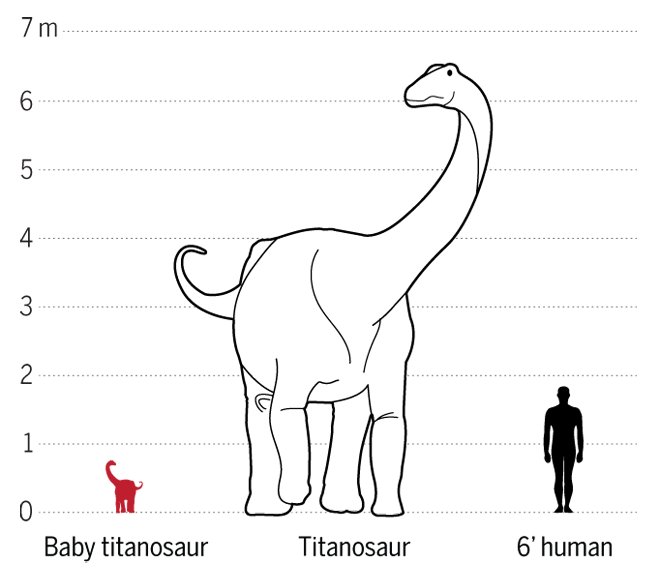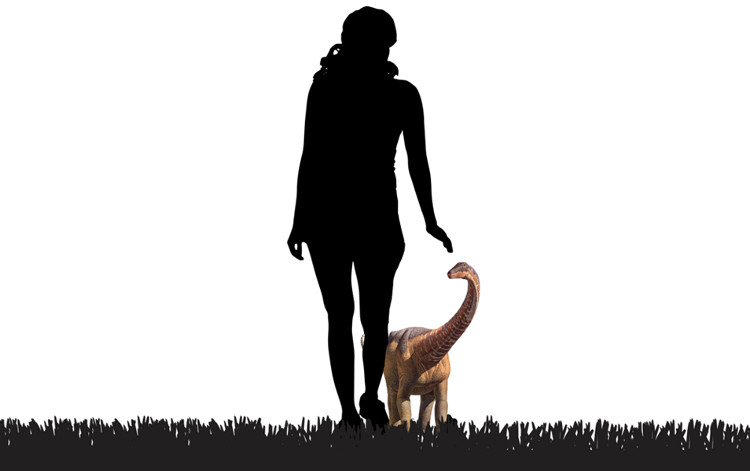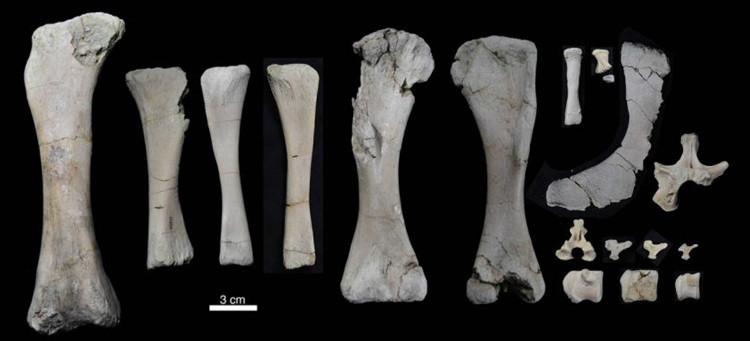Newborn dinosaurs are only about one-third the size of a human being but have a very fast speed
Do you believe that after only a few months can an infant grow into a young man and then live independently?
Certainly humans cannot do it, but this is the growth of Rapetosaurus , a dinosaur that lived at the end of the white chalk. This discovery not only provides an insight into the mysteries of dinosaurs, but also plays an important role in archeology, completely changing the archaeologists' view of fossilized specimens. in the future.

Compare the size of newborn, adult and human dinosaurs.
With a height of more than 15 meters, possessing an extremely long elephant-like neck and legs, Rapetosaurus is a large dinosaur, but compared to other Titanosaurs, it is smaller in size. Titanosaurs is the largest genus of dinosaurs that ever lived and is also the last branch of the Sauropods lizard legs that existed at the end of the Cretaceous, about 65-70 million years ago, at the time just before the dinosaurs went extinct. .

Artwork of the size of newborn and human Rapetosaurus.
Sauropods have long, long-tailed necks, belonging to plant-eating dinosaurs and are known as an extremely fast-growing species from birth to adulthood. However, scientists need a skeleton of a newborn Sauropods to better understand their "blown-out" process. Research conducted by scientists at the University of Macalester led by Professor Kristina Curry Rogers, who in 1996 first discovered the skeleton of an adult Rapetosaurus. And then, Rogers continued to discover a newborn Rapetosaurus skeleton located in fossil-rich areas of northwest Madagascar.

Fossils of dinosaur bones found.
The team used two techniques simultaneously during the analysis of the newborn dinosaur skeleton, including: bone tissue analysis (in other words, observing bone cells below the microscope level) and X-ray tomography techniques (basically taking bone samples through CT scanners). Results showed that Rapetosaurus has a weight of about 2.5 to 4.3kg when born. But only a few months later, when the dinosaurs the group discovered were starved to death, it weighed about 40kg.

Rapetosaurus was found to be half the size of a newborn African elephant.While an adult Rapetosaurus may be three times larger than an adult African elephant.
According to Stephen Brusatte, an archaeologist at Edinburgh University, who did not participate in the study, commented: " The evolution of the extremely fast growth rate in the giant dinosaurs is a in the greatest achievements in evolutionary history ". At the same time, not only dinosaurs have a rapid growth rate, but researchers also believe that they don't need too much help from their parents to be independent. Despite their rapid growth, their shape and proportion are still maintained. They said: "Basically the dinosaur bones of the baby look like a miniature version of the mature individual".
On the other hand, the bone weight of Rapetosaurus also shows signs of bone reorganization - a process that takes a long time, when the old bone tissue is reabsorbed from the skeleton and replaced by the new tissue. Rogers believes that most animals do not begin the process of reorganizing bones until they are fully independent. Finally, the researchers examined and compared dinosaur cartilage compared to other modern animals. Accordingly, modern animals that require a lot of care from their parents form thick and irregular cartilage, while Rapetosaurus cartilage is as thin as modern birds that do not feed their babies.

The illustration illustrates the speed of Rapetosaurus dinosaur bones and their size compared to humans.
According to the anatomy professor and vertebrate archaeologist at Florida State University, the conclusion about the growth of Rapetosaurus dinosaurs in this study is quite solid. He was impressed with the approach of using baby dinosaurs and adults to compare with each other, in relation to modern species. At the same time, he thought that Rapeotosaurus would be independent from birth and their "giant parents" did not take the time to look after them.
Although the scope of this study revolves around a species of Rapeotosaurus, it provides an interesting perspective on dinosaur life that contains many things that humans do not know. On the other hand, it also sets the stage for other archaeological studies in the future.
- Giant size of dinosaurs
- Giant source of dinosaurs
- 7 mistakes when using the high speed can cause the electric drive to explode, causing harm to the whole family
- Running speed is related to human hunting strategy
- Why are long-necked dinosaurs gigantic?
- Why can't humans run as fast as ... newspapers?
- Fast food makes you aggressive?
- Terrifying perspective when the Earth spins twice as fast as it is now
- 10 weird, hard to imagine dinosaurs
- Dinosaurs used to live in the water
- Eating dinosaurs defends themselves by growing fast
- Compare the size of people with the universe
 Discovered an ancient centipede fossil 99 million years old
Discovered an ancient centipede fossil 99 million years old Discovered bat-like dinosaurs in China
Discovered bat-like dinosaurs in China Discovered a 200-year-old bronze cannon of the coast
Discovered a 200-year-old bronze cannon of the coast Discover 305 million-year-old spider fossils
Discover 305 million-year-old spider fossils